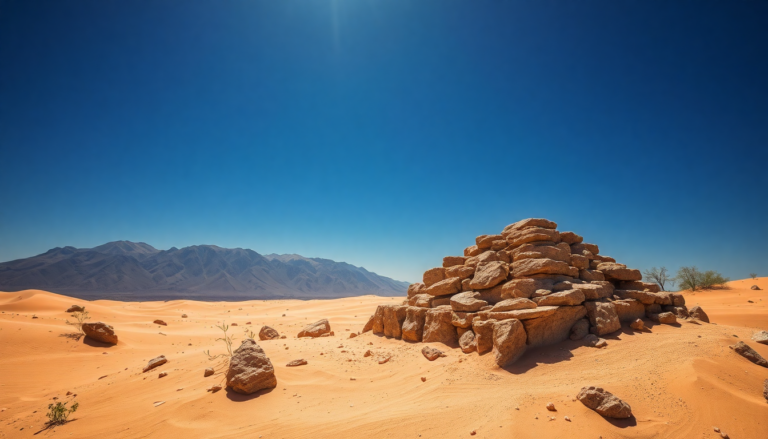Argomenti trattati
Imagine wandering through the sun-baked expanse of the Judean Desert, where each grain of sand whispers secrets of a bygone era. Recently, a remarkable discovery has emerged from this arid landscape—a pyramid-like structure that has captivated researchers and travelers alike. This find isn’t just a matter of stones and dust; it’s a portal to understanding life over two thousand years ago in this historically rich region.
Discoveries that rewrite history
Located near Nahal Zohar, a team from the Israel Antiquities Authority, along with local volunteers, has been hard at work excavating this monumental site. As they sift through layers of earth, they’ve unearthed not only the intriguing pyramid structure—standing at a striking five to six meters tall—but also a treasure trove of artifacts that could redefine our understanding of the past. Imagine the thrill when they found ancient Greek papyri, bronze coins from the Ptolemaic and Seleucid empires, weapons, beautifully crafted wooden furniture dating back 2,200 years, and even colorful textiles! It’s like stepping into a time capsule, a thrilling experience for any history enthusiast.
Understanding the significance of the finds
Initially, the excavation team believed they had stumbled upon a tomb, but upon closer inspection of the structure’s walls, it became clear that this was no ordinary burial site. Researchers now believe that this pyramid-like edifice served as a fortress during the Hellenistic period, a time when the region was heavily influenced by Greek culture following Alexander the Great’s conquests. The implications are profound—this site offers a glimpse into the daily lives of those who inhabited the area, their customs, and their interactions with surrounding cultures. As the excavation director Matan Toledano noted, this is one of the most complex and rich excavations ever undertaken in the Judean Desert, revealing significant insights into historical life.
Climate’s role in preservation
One cannot overlook the role of the desert’s arid climate in preserving these incredible finds. The dry conditions have allowed artifacts to remain in surprisingly good condition, allowing modern researchers to examine them as closely as possible to how they were originally used. I remember a time when I visited a similar site and marveled at how the environment could freeze time, offering us a chance to peer into the past. This preservation is crucial for archaeologists, as it provides a more comprehensive view of life during the Hellenistic period, a time that has often been overshadowed by other historical events.
The pyramid structure: a mystery yet to unfold
What purpose did this pyramid serve? That’s the million-dollar question. Some researchers speculate it could have been used as a lookout point over significant trade routes, while others believe it might have served as a monumental burial site or a ceremonial space. The possibilities are endless, and the excitement in the air is palpable as scholars debate the structure’s intended use. Personally, I find the idea of it being a ceremonial site particularly fascinating—imagine the rituals that might have taken place there, echoing through the ages.
Historical context: Hellenistic influences
The Hellenistic period, which began in 332 BC with Alexander the Great’s conquests, brought profound changes to the region. The Judean Desert, once a remote area, became a melting pot of cultures under the rule of the Ptolemaic and Seleucid empires. As many know, this was a time when Greek art, philosophy, and customs began to permeate local traditions, shaping a unique cultural landscape. The artifacts discovered at this site provide tangible evidence of this cultural exchange—Greek coins mingling with local wares, ancient texts reflecting a blend of thought and tradition. It’s a thrilling reminder of how interconnected our histories truly are.
Looking ahead: the future of the excavation
What lies ahead for this excavation? As the research progresses, the archaeological team is eager to learn more about this extraordinary site. Each new find adds a layer to our understanding of the past, and news of their discoveries continues to excite both historians and travelers alike. The excitement is infectious! I can’t help but think of the many adventurers who dream of following in the footsteps of these archaeologists, unearthing the secrets of ancient civilizations. It’s a journey that not only enriches our knowledge but also fuels the wanderlust in all of us.
Final thoughts
The discoveries in the Judean Desert are not merely relics of the past; they are threads weaving together the narrative of human history. As researchers continue to excavate and analyze these finds, we gain a deeper appreciation for the complexities of ancient life and the enduring legacy of our ancestors. This site stands as a testament to the rich tapestry of human experience, waiting for those daring enough to explore its depths. So, whether you’re an intrepid traveler or a curious history buff, the Judean Desert beckons—ready to unveil its stories, one layer at a time.

